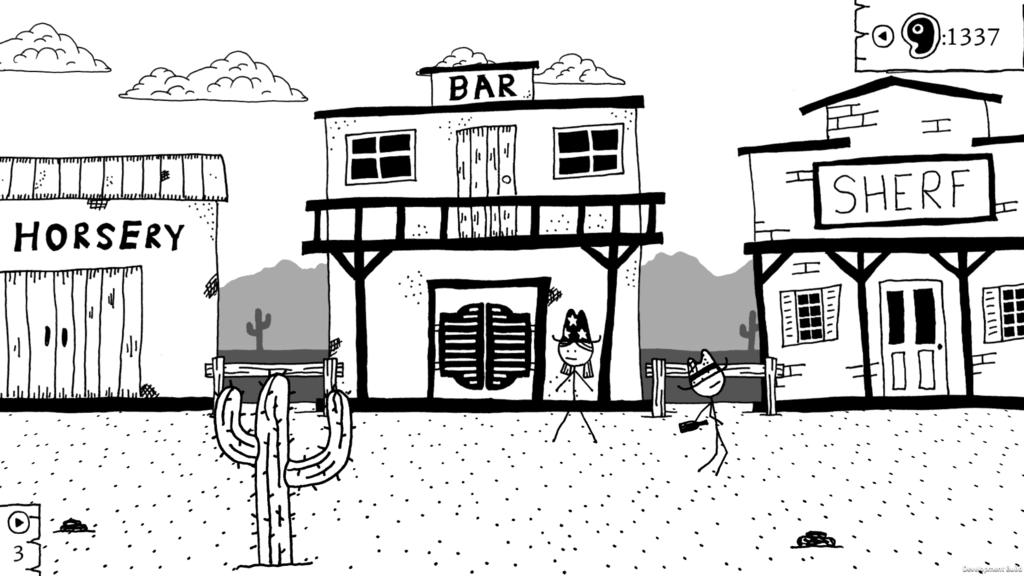[symple_box style=”boxsucces”]
Appolicious: To start, West of Loathing is a surprising turn for a series typically based in medieval fantasy. What led to the Loathing series dipping its toes into the Wild West?
[/symple_box]
Zack Johnson: Kingdom of Loathing is such a mishmash of genre stuff that we were excited about the idea of making a game with a tighter set of constraints. As far as the Wild West in particular, I’ve always felt like it was weirdly underrepresented in RPGs. I think it’s very similar to medieval fantasy in a lot of ways: a comprehensible level of technology (guns instead of swords), a dangerous environment (snakes and outlaws instead of dragons and brigands), and a primal, hero-centric mythology (gunslingers instead of knights).
App: Loathing is known for its low-fi visual aesthetic of stickmen and sketchbook characters. What led you to this visual direction all, and why do you think it’s maintained such an enduring presence?
[/symple_box]
ZJ: When I first started working on Kingdom of Loathing, it was a one-man project, so the art had to be limited to what I was capable of doing myself. I think having drawn this stuff for 15 years I’ve gotten enough better at it that it counts as an actual style now, rather than a compromise. I later read Understanding Comics, and its points about abstraction making characters and objects more relatable to the viewer really struck me as a possible reason the response to the art has been so positive over the years.
App: How was it, developing a single-player take on Loathing? Were there any surprises along the way?
[/symple_box]
ZJ: It was really freeing in a lot of ways. Being able to quickly design items and encounters without worrying about the way they might affect other players or the in-game economy was very liberating. As far as surprises, not really. The development process for West of Loathing was… eerily smooth.
App: West of Loathing features many choices to the player, both in and out of combat. What challenges did the team face imbuing the Loathing tone into more linear story choices and turn-based brawls?
[/symple_box]
ZJ: The biggest issue with branching narrative stuff is probably QA. Testing every possible thing in the context of every previous thing that might affect it took up a lot of time, and it’s something that couldn’t really happen until the game was basically done.
App: I have to ask – why is meat the core currency of the Loathing series?
[/symple_box]
ZJ: When I first made KoL, I drew a single sheet of art with some characters, monsters and items on it. When it came time to build the basic RPG code, I realized I hadn’t drawn any coins or anything, but there was this nice picture of a steak…
App: With West of Loathing finally coming to mobile, can you give us some insight into the work of bringing a PC title to handheld?
[/symple_box]
ZJ: We’ve had to do a lot of optimization to get the game down to a reasonable size for mobile devices, and a lot more to get the textures looking right at the huge variety of resolutions we need to support. We always had the game running on iPads for demo purposes, so that’s not such a big deal, but for phones, we’re also having to do a really significant overhaul of most of the game’s UI so it’ll work okay on a small screen.
App: Unlike a lot of titles in gaming, West of Loathing is very relaxed about death. The game even makes light of it with humor. What are your thoughts on difficulty in games?
[/symple_box]
ZJ: I don’t mind a hard game, but I think extreme difficulty would clash with the funny tone we’re shooting for with West of Loathing. Our games are mostly just delivery vehicles for jokes, and we’ve learned over the years that the best way to do that is to mostly stay out of the player’s way.
App: The Loathing games have, until now, been relatively static visually. How was it, finally putting motion to the Loathing designs for slapstick battles and background gags?
[/symple_box]
ZJ: We got very lucky with Wes Cleveland, our animator. From the very start, he was able to bring the Loathing art to life in a way that felt right, and was consistently visually funny.
App: Comedy is one of the hardest genres in games, yet Loathing keeps hitting it out of the park. What would you say are the best ways to ensure a game is genuinely funny?
[/symple_box]
ZJ: I think the thing we’re good at as a studio is never, ever being out of the mood to make things funny. It lets our style soak into every aspect of the game — the UI, basic descriptive text for items and stuff, the animations, the artwork. A lot of games are funny for the first little while and then run out of steam. Since the comedy is really the thing we think differentiates us as a studio, we try hard to stay in a mode where the first question about every design or writing decision is “is this funny?”
App: West of Loathing is Asymmetric Publications’ third video game, accompanied by the tabletop Kingdom of Loathing spin-off. What inspired this growth in new games? Is there potential for the Loathing-verse to expand further?
[/symple_box]
ZJ: Kingdom of Loathing is getting a little long in the tooth, and the company really needed another source of income if we were going to continue to operate at the level we were at. We developed the West of Loathing engine to be extremely flexible and data-driven, so yes, I’d expect more games like this one over the next few years.













